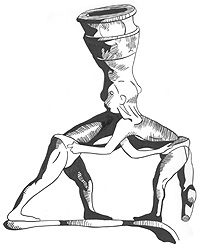I recently had two conversations concerning scholastic athletics with young people that have left me with a nagging sense that things haven’t changed for high school level team sports since I was a kid.
Briefly, I got out of football after three years because I knew that my coaches did not care about any of us as individuals, and also because they were the least intelligent members of the school faculty—by a long shot!
My brother’s soccer coach was highly intelligent, the advanced placement history teacher. He asked me to play for his team even after I told him I was no good at playing backyard soccer at all. He informed me that I would spend most of my time on the bench and that I would only have three purposes: be put into the game to injure the other team’s lead scorer; to come off the bench during a brawl to protect his leader scorer [my brother]; and to pick a fight with, and disable, my counterpart on the other team. As much as I liked the idea of hurting opponents something about this arrangement struck me as unethical and I declined. Maybe it was what my boxing coach had said about the only way to really fight being ‘alone’ and the only place to do it honorably being ‘in the ring’.
My wrestling coaches and boxing coaches demonstrably cared about all of us and were generally far more knowledgeable concerning the nuances of their sport than the football coaches. I understand the later point to be a function of scale, and that top pro football coaches are among the smartest men in sports. However, the beer drinking Monday morning quarterback, so many of whom are required to shepherd the lower reaches of such a vast sport, are necessarily made of lesser stuff. Vast numbers seem to dilute the quality of the experience.
The 14-year-old Girl
I train a stick-fighter who also takes karate lessons. She has been sidelined in the past year three times for injuries. All three of these injuries come from the noncontact sports of softball and field-hokey. Stick-fighting and karate may sound brutal, but since their practice is a form of self-defense, the entire focus of the sport revolves around avoiding injury as you impose your skill and will on the opponent.
It seems counter intuitive that such an activity is safer than softball, so let me give you an example. Dan was a powerful man who had over 400 wrestling matches and 25 boxing bouts to his credit, and could easily bench press 500 pounds. He had to stop training for MMA because, while coaching softball and soccer, he sustained too many ankle injuries! Yes, his lifetime of ball sport ankle injuries had made it unsafe for this monstrously dangerous man to walk across a grassy field for fear of a hidden depression.
The 15-year-old Guy
The day after I admonished my female stick-fighter for engaging in unsafe ball sports, I spoke with a young man who had asked me once if I would train him to fight with weapons. Such a request from a minor—a friend of the family in this instance—is always followed up by an interview that does not seem like an interview, but is in fact a clandestine attempt by me to decide if this youth is mature enough to learn how to fight. This man-child, because of his size alone, would [and has been] nothing but an asset to be recruited by any high school football coach. But a boxing, stick-fighting or MMA coach [at least all the ones I know] would devote more time to assessing his ‘coachability’ and discouraging his participation, than on something as blind as recruiting.
Our conversation began on the note that he had already been injured in a football weight-training session, and the season is still months away! I asked him to describe the circumstances and nature of the injury. He had not been examined or treated by a physical trainer or any form of licensed medical person. His coach just told him to do the standard stretches prescribed by the school physical fitness program.
When I diagnosed his back injury as a spasm of the quadrates lumbarum he thought I was insulting him and began hovering over me threateningly and suggesting I not make fun of him. With the aid of my son I got him calmed down enough to permit him to describe his understanding of stretching, which was false and incomplete. I further determined that he was actually operating in a supervisory role in the weight room and that he and other emotionally immature young men were charged with one another’s safety.
When I offered to explain a Doctor’s scientifically developed stretching program that had brought me back from a crippled state the boy announced that he had complete faith in his coach’s system, even though he knew that the coach did not like him [a fact he brought up unbidden]. The teen athlete then left the room. I turned to my son and told him that apparently nothing had changed in high school football since I was a kid.
Let me be clear people, high school football teams still promote student supervised weight training, with free weights. I spent 4 years involved in power lifting, weight lifting and body building, and can tell you that football weight training has typically been regarded by people involved with these sports as laughably dangerous and primitive. And, I might add, that I know no one who has competed in power lifting, weight lifting or body building who has not been injured in training. Free weights are a very important tool for mature athletes if properly utilized under professional supervision. Putting three boys in a room full of weights always results in a weight lifting contest, and often also results in negligent safety procedures while the boys not pumping the iron goof off, as boys are want to do.
That 15-year-old kid who mistook a muscle for an insult might be charged by an absent coach with the safety of your kid in the weight room. Let us be clear that free weights are very dangerous, and have a similar injury-to-use ratio as cigarettes. Free weights are never recommended by boxing coaches because of the known injury correlation, and the fact that a fighter takes 18 months to bring to competition. Football players, however, must be brought from football camp to competition in 6 weeks. That quest for the explosive power gained by free weights washes some out in the weight room. But most players will make it to the post season before the inevitable joint injuries resulting from that type of weight training will take hold. By then they have already put the points on the board, and can be replaced next year by fresh meat.
What I concluded from the 15-year-old guy’s clandestine interview was this:
I wish to maintain a reality where that 14-year-old girl can beat the shit out of that 15-year-old boy [which is currently the case], and will do my part to keep it that way by declining to train him. He is already in a position to hurt people by accident. There is no sense in giving him the ability to hurt others on purpose. Besides, I judged him to be so uncoachable, largely due to his involvement in ego-saturated adolescent team sports, that I would not be able to discipline him well enough for him to learn how to defend himself, without actually hurting him myself. And I refuse to turn out fighters who cannot defend themselves.
Why Are Team Ball Sports more Dangerous than Combat Sports?
Let us compare football to boxing, both being the most brutal of their kind. Both of these sports feature high risk of low level head injury early on and throughout the career of the athlete, and low risk of high level head injury at the peak and end of that career.
What are the other risks?
Boxers suffer some hand and shoulder injuries.
Football, since it is aimed at something other than hurting and protecting athletes, results in unprepared players being in harm’s way often, and hence results in every conceivable kind of injury. Boxing injuries are comparable to bar fighting injuries, while football injuries profile closer to automobile accidents.
What are the other factors that make football more dangerous than boxing?
Boxing coaches work with 1 to 5 fighters. Anything beyond 5 fighters is regarded as requiring an assistant.
Football coaches work with about 10 players a piece, depending on the level of play, with the most vulnerable and least prepared players drawing the worst player-to-coach ratios.
Boxing coaches are insulated by many of the external pressures to ‘use’ players for ‘the team’ that team sport coaches are subject to. A boxing coach normally doesn’t have to worry about getting fired by a third party, because, unlike a football coach, he is not an employee, but a freelance operator contracted to the fighter, who can work with his fighter anywhere. The single greatest difference between team sports and fighting is who the coach works for. A boxing coach may be employed by a third party, but, even if this is the case [and it is not normal] the fighter usually retains the authority to dismiss him.
The best thing about sports for the development of impulsive youth into responsible adult is the mentor relationship. In boxing the mentor relationship is always present, representing the corner stone of the relationship. The football coach has too many players to mentor, and confines this relationship to assistants and squad captains.
Boxing discourages anger, as ineffective.
Every football program I was involved in cultivated anger. Ray Lewis, leader of the Super Bowl Champion Baltimore Ravens was worshipped for his anger displays, and even had an anger team to fan his bile into an emotive crescendo for the cameras. I was once pulled aside by two high school football coaches about me teaching their players how to fight. They said it was alright with them [I was handling 7 of their guys] if I taught these kids combat so long as it made the kids ‘meaner’ made them ‘want to hurt the opposing players’. When I confided that I was actually ‘beating the anger out of them and replacing it with discipline’ they were horrified, and honestly so stunned that they were at a loss for words.
I love boxing and only like football, so am surely guilty of some bias here. However, the uncontrolled anger and aggression that I saw demonstrated by scholastic football players my entire life, coupled with the fact that I beat every high school football player I ever fought as a junior high school boxer, has left me with something of a low opinion of the character development aspects of football.
On the other hand, I have been associated with some very fine men who played and coached [I am certain my Uncle, who coached for VMI and Army, did not promote anger.] football, including some of my most responsible fighters. When I was a teen the guys that got drunk, snorted coke and gang raped girls were football players. Ten years ago I interrupted 4 high school boys, two of whom played for the local high school football team, who were in the process of loudly threatening to gang rape a junior high school girl. I had a pair of rattan sticks and a hockey helmet. They had three baseball bats and a car. If you want to find out how it ended buy When You’re Food, available on the Harm City page.
So again, I’m packing some bias when it comes to judging the character building aspect of football, and likewise boxing, which was the sport that largely redeemed me as a person even though I wasn’t really very good at it.
Overall, it is my contention that choosing a combat sport over a team ball sport results in a smaller ‘class size’ that virtually assures mentoring; narrows the injury profile because of the focus on injury; and requires a higher level of self-discipline, which is, to me, the single most important factor in successfully interacting with other adults. If you also want the benefit of the team aspect, than find a ‘fight team’ rather than a ‘club’. In many respects MMA teams mix the best aspects of boxing and team sports [since many of the coaches have a wrestling or traditional martial arts background] and are probably your best bet.
If you decide on football, as a test I suggest asking if the coach promotes unsupervised free weight training, keeping in mind that supervision by other students constitutes unsupervised. Any coach who promotes free weight training should also be able to name all of the muscles listed on the anatomy chart you bring to his interview.
Boxing teaches the lesson that the art come first, the fighter second, and the team third.
Football teaches the lesson that the team comes first, the game second, and the player third.
If you are running a predatory pyramid scheme for raping seniors of their life savings or despoiling an already impoverished community of its resources make sure you recruit people schooled in the game of football, not the art of boxing.











Boxers, MMA fighters: you can usually tell the folks that actually train, and train hard, because in addition to their skill set and iron bodies, they have a generally passive nature, they exude humility, project a conscious sensibility and are calculating in how they handle themselves, in and out of the gym. Not all, but many - lets say 70% ?
Jocks are usually assholes. Not all, but many - lets say 70% ?
MMA and its many associated training programs can be highly effective in turning out skilled, well-rounded fighters. But it's also an entry point for said-angry-sports-goons to train in the combat arts. How do we navigate ourselves through this shopping-mall of combat choices?